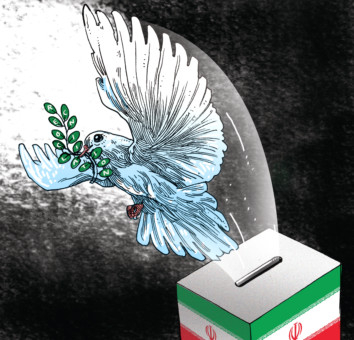
Hassan Rouhani won the May 19 Iranian presidential election by a landslide. Rouhani won 57 per cent of the votes of the 56 million eligible voters while his rival, the conservative Ebrahim Raisi, a protégé of Iran’s Supreme Leader, Ayatollah Ali Khamenei, came in second with 38.5 per cent.
Shortly after the final results were announced, Ayatollah Khamenei, referring to the high turnout (75 per cent), said in a statement that “the victor of the elections were the Iranian people and the Islamic republic establishment.”
However, there are reasons to believe that the election was a display of a quiet civil rebellion on behalf of the millions of voters against the deep state, which the conservatives/hardliners dominate. This primarily resulted from the campaign that Rouhani ran: polarising the election environment and urging people to choose between fanaticism and modernism, “honesty and duplicity”, and as he repeatedly mentioned, to choose “peace and reconciliation [with the international community]” rather than “tension and violence.”
The statements that Rouhani made, and the positions that he adopted, during his campaign were completely unprecedented by a presidential campaigner. With many fewer assaults than what Rouhani made on the deep state in the last four weeks, one could spend years in jail. Rouhani, known as a moderate, morphed into a reformist, but even the most radical reformists would not dare to make such remarks.
In a speech on May 8, he said, “[In the upcoming election] the people of Iran will once again announce that they don’t accept those who only knew of the executions and imprisonments for 38 years.”
He was not only clearly targeting Raisi, who, until a year ago, was a high-ranking member of the judiciary, but also the judiciary system as a whole, a stronghold of the conservatives, which has been in constant friction with Rouhani in the last four years. He was in fact accusing a powerful arm of the deep state of repression while the judiciary system is under the direct supervision of the supreme leader.
In the aftermath of the 2009 upheavals and the emergence of the Green Movement, which protested the re-election of Mahmoud Ahmadinejad, Iran’s former president, Mohammad Khatami, the leader of the reform movement in Iran, was labelled as one of the leaders of the sedition. This name — the “sedition” — was given to the Green Movement by the conservatives. Later on, the Iranian media were banned from publishing statements and images of Khatami.
The deep state considers supporting Khatami an unforgivable sin. Just last year, Ayatollah Khamenei remarked, “My positions about the sedition ... are fully clear and I am sensitive to this issue, and the yardstick is refraining from supporting those who spearheaded the sedition.”
Debunking the supreme leader’s position in his May 13 remarks, Rouhani said: “The reform [movement] will not be isolated ... Let us say hello to reform ... Let us say hello to Sayyed Mohammad Khatami.”
Another point of contention between Rouhani and the leader was over the nuclear pact signed between Iran and the world’s six powers in 2015. Khamenei sought to downplay the significance of the nuclear agreement, thus demoting Rouhani. He insisted that the claim “that in the absence of the nuclear deal, Iran would have become engulfed in war ... is a pure lie.”
During his campaign, Rouhani repeatedly ignored Khamenei’s standpoint and warned the nation that “people should determine whether they want to live with dignity or [under] the malevolent shadow of war.” Observers in Iran maintain that many voted for Rouhani to reject the hardliners out of fear of a destructive war.
From moderate to reformer
One factor that shaped the collective anger, particularly in the large cities and mainly among the young urbanites, was the obvious anti-Rouhani stance that the Iranian state-run television and radio (seda va sima) took during the election. There is no private television or radio network in Iran. The head of seda va sima is chosen and appointed by the leader.
Again, in an unprecedented move by a presidential candidate, Rouhani sought to mobilise people by asking them to vote for him if they wanted to get rid of “the political gang [that] ... runs the network.”
The highlight of this election race was Rouhani’s clear shift from being a moderate to being a reformist, thereby establishing himself as the leading figure opposing the deep state in the absence of the late Akbar Hashemi Rafsanjani, Iran’s former president (1989-1997), who passed away in January.
To conclude, thanks to Rouhani’s novel campaign, this election became a referendum in which the majority of voters rejected the deep state’s vision and behaviour, negatively affecting the life of the nation in a variety of categories from economy to social life and politics.
That said, one should not forget the reality that almost 40 per cent voted for Raisi, who represented the conservatives. In his post-election statement, Raisi said, “Close to 16 million Iranians voted for change. This is a monumental milestone that cannot be ignored in the country’s political arena when it comes to decision-making at the macro level. I, based on this popular support, will utilise all the means available to pursue the people’s demands ...” The question now becomes: “After the emergence of such a wedge of open hostility between Rouhani and the hardliners, and indirectly between him and the leader, will Rouhani be able to run the country smoothly and fulfil his promises regarding peace and reconciliation within the country and with the outside world?” Unlikely.
Cyrus Namjoo Moghadam is a freelance writer.










